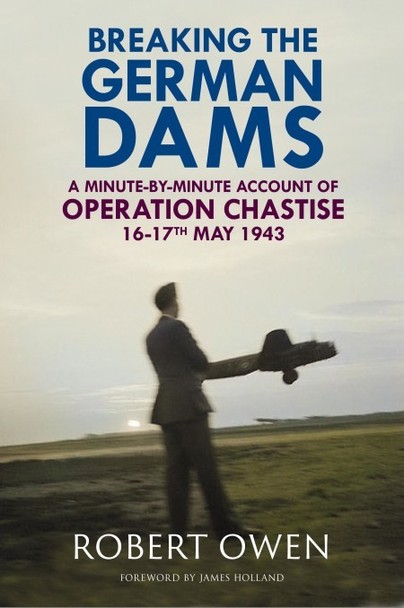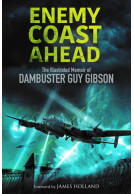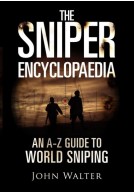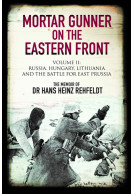Breaking the German Dams (Hardback)
A Minute-By-Minute Account of Operation Chastise, May 1943
(click here for international delivery rates)
Order within the next 10 hours, 54 minutes to get your order processed the next working day!
Need a currency converter? Check XE.com for live rates
| Other formats available - Buy the Hardback and get the eBook for £1.99! | Price |
|---|---|
| Breaking the German Dams ePub (17.2 MB) Add to Basket | £6.99 |
“This was Der Tag for 617 Squadron […] from eight o'clock onwards the scenes outside the crew rooms were something to be remembered."
“I watched each Lancaster become airborne from the window of my office but I did go outside to see all the boys roaring away into the fast approaching twilight, and that was a great thrill because they were flying at less than 150 feet from the ground. I just stood and gaped, hardly able to realise the significance of it all.”
On the evening of Sunday 16 May, 1943, the sound of Lancaster bombers fills the night air around Lincolnshire as two waves of Allied aircraft start their engines and take off from RAF Scampton in the direction of the Ruhr Valley. The mission? Attack the German dams on the Eder, Möhne and Sorpe rivers using special “bouncing bombs”. This was Operation Chastise.
In this remarkable work, No. 617 Squadron expert Dr Robert Owen takes a microscope to the raid, guiding readers through the events of 16 and 17 May 1943 in astounding chronological detail. Each action leading up to, throughout, and following the raid is signposted with a precise time stamp, affording readers an informative, gripping and easy-to-follow reading experience. Owen’s compilation of a wide range of first-hand accounts from those involved in the Dambusters Raid complements this minute-by-minute retelling perfectly, and adds to the readers’ understanding and appreciation of this astonishing military operation.
With a foreword by World War II aviation expert and author James Holland, Breaking the German Dams is a hugely impressive feat of non-fiction writing about one of the most awe-inspiring operations in British military history. Readers will be left incredibly well-versed in — and moved by — the extraordinary story of Operation Chastise.
Rating: 5 out of 5 stars
NetGalley, Mark Lardas
The Dambuster Raid In Detail
It has been 80 years since the Royal Air Force launched an airstrike against three dams in the German Ruhr. Flown at low level, it was one of the most daring, and successful, air raids of World War II
“Breaking the German Dams: A Minute-By-Minute Account of Operation Chastise, May 1943,” by Robert Owen, is the latest effort to document the raid. It may be the most successful.
Owen uses the perspective of time to produce what is probably the most comprehensive account of the Dambusters raid ever written. This book covers all aspects of the raid, from its conception through its execution. It follows what happened to the participants – on both sides – after the raid was over.
Owen examines how the raid was conceived, how it was planned, and how the 617 Squadron, which executed the raid was assembled and trained. He presents the obstacles faced by those advocating for it, right up until the first Lancaster on the mission left for Germany. Skeptics included Air Marshall Arthur Harris, who led Bomber Command.
The heart of the book is a minute-by-minute account of the raid. Owen follows every aircraft from the time it left the ground until the moment it returned to Earth. He traces both aircraft that crashed and those which returned safely. He recounts the fate of every participant.
He provides the German perspective of the raid, including those involved in the air defense of Germany: crews manning the antiaircraft guns and those participating in civil defense along the route the bombers took. He recounts what happened to the civilians downstream of the two dams successfully breached by the raid.
He delivers a dispassionate assessment of the raid’s results. He shows that from a cost-benefit perspective the raid delivered results far in excess to the costs incurred in mounting it, both in material and lives. He also shows it played a significant part in Harris’s Battle of the Ruhr, delivering a better return than some of the 1000-plane raids mounted. At the same time, he shows how the results could have been improved significantly with a few minor changes.
“Breaking the German Dams” is worth reading for anyone with an interest in World War II’s air war. It is a gripping account of the raid. It also shows how time adds perspective. Information unavailable immediately after the War but now accessible added significantly to Owen’s account.
Review as featured in
The Armourer
Highlight: '...exciting and informative but also hammers home how dangerous it all was... Highly recommended.'
Competition as featured in
RAF News, August 2023
Article: Think that you know everything about the Dams Raid? Think again
Rating: 5 out of 5 stars
NetGalley, Susan Moffatt
As a child I grew up in a house where my Dad was fascinated by the story of the men of 617 Squadron - we had books, we had paintings, he helped a friend with research for a book and I have no idea how many times I have seen the film.
It was such a privilege to read this book in this the 80th anniversary year of the Dams Raid.
Rating: 5 out of 5 stars
NetGalley, Michael Neill
This is wonderful new book on the already well covered story i.e. the bombing of the German damns in the Ruhr valley during WW2. Dr Owen has thoroughly researched the subject and brings together multiple sources to tell the story from conception through to execution. The latter part being a minute by minute timeline of the raid as told by those who took part and from official records from the RAF. The Luftwaffe and the German ground forces.
The general story is well known of how Barnes Wallace came up with a “ bouncing bomb” designed to evade protective torpedo nets and land next to the damn wall detonating once it had sunk to a depth of 60 ft focusing the percussive blast to blow out the very thick damn walls. Dr Owen takes you through this design phase and early trials and the formation of the special squadron of Avro Lancasters under the leadership of Wing Commander Guy Gibson where the skills of low level nighttime flying and precision bombing are quickly developed. The timeline of the raid itself and the anecdotes from the air crews is very enlightening and you understand why the casualties were so high on such a raid literally flying at treetop height at nighttime with power lines, church steeples and sand dunes coming at you out of the dark traveling at 300mph…frightening!
There are many nuances to the story which I had not heard before and I commend the author for his skill in being able to bring in a lot of detail without it being too repetitive nor losing the momentum of what is an exciting story.
The final part of the book is an attempt to answer the question of whether it achieved its aim and whether it was worth the sacrifice. Again I commend the Author for deftly avoiding a debate of the morality of bombing targets with such a high civilian casualty rate. This is not the book for such a debate nor should there be any deflection from the bravery and sacrifice of those who took part in the raid. Instead Owen focuses on the reported facts on the damages caused by the raid, the efforts and resources required to rebuild and reinstate and the disruption to the war effort and psychological blow to morale.
I would thoroughly recommend this book to anyone with an interest in WW2 history or just some who would like to get a feel for what it was like flyingnightime raids over Germany.
Rating: 5 out of 5 stars
NetGalley, Kevin Manley
Unsurprisingly, the 80th anniversary of the Dambusters Raid has led to the appearance of a number of new books on this already well-documented operation. Max Hastings offered his contribution last year and this year sees Dr Owen’s masterly account published. As a child of the immediate post war years I had become aware of The Dambusters from the film, starring Richard Todd and Michael Redgrave. At school, too, we learnt the words that accompanied the iconic Dambusters March from the film.
Given all that has already been written about the dams raid I approached this book with some trepidation. Could there really be a new angle or a different approach that justified yet another book. Prospective readers, who may share these misgivings, are likely to experience the same relief that I felt as I began Dr Owen’s quite excellent account. For those who want to understand the genesis of the plans for the attack on the dams and how both the plan and the technology were developed and refined this book fits the bill. No corners are cut and the reader feels to be almost watching the planned raid take shape. Dr Owen also steers a necessary and careful path that pays proper tribute to the courage and heroism of the crews, whilst avoiding any ‘gung ho’ chauvinism; the inevitable casualties experienced as a result of the sudden, catastrophic inundation below the Möhne and Eder dams are also treated respectfully. The author takes care in his final reckoning to give a carefully balanced analysis that considers the essential question of ‘was it worth it?’ In doing so, Dr Owen explains that subsequent international agreements have outlawed attacks in civilian infrastructure. This approach also avoids the unhelpful approach sometimes seen that applies a current legal and/or ethical framework to historical events. Finally, it is worth commenting briefly on the device used in this book when describing the raid using a chronology. Whilst this may suffer from interrupting a narrative flow it does, nevertheless, illustrate what an extensive operation this was with many elements that needed to interlock if it were to be successful.
Strongly recommended.
Rating: 5 out of 5 stars
NetGalley, Peter Coxall
I thought that I was pretty conversant with the facts and figures behind Operation Chastise. How wrong could I be!
The author has undertaken massive research into the 617 Squadron’s dam’s raid and has brought to light many previously unpublished, very detailed facts from both the RAF and the German perspectives. The book gives a minute-by-minute account of the raid, from the pre-operational briefings through to the final return of the survivors.
I was surprised by the several inconsistencies in the various eyewitness accounts, but these were totally understandable in the fog of war and fear of violent death. Interestingly many of the aircraft did not fly their pre-planned routes due to low-level navigational issues, but were able to find their way to their targets.
As we are all aware, the overwhelming bravery and skill of the crews of the crews plus the leadership of Guy Gibson made this operation an amazing success. But we must also take into account the tenacity of Barnes Wallis and the hard-working ground crews who made it possible.
I have a particular interest in the dam raids, my mother was a WAAF who worked directly for Gibson at that time. My father flew Lancasters with 57 Squadron, who were also stationed at Scampton during this period. His squadron couldn’t understand why 617 Squadron weren’t flying nightly operations into Germany, and why they were having such a ‘cushy’ life. The day following the raid, my father and his colleagues were shocked by the significant losses of aircrew from their sister unit.
A brilliant book and thoroughly recommended to WW2 buffs.
Rating: 5 out of 5 stars
NetGalley, Ron Baumer
A truly interesting story on raid by the British on the German dams in WW2. The story takes you through the planning, development, execution of the mission and the results. The men who participated in the raid were inspirational and what they endured was heartbreaking. A great read!
Rating: 5 out of 5 stars
NetGalley, Steven Sherwin
An intriguing tale of a British raid against the German dams during the Second World War. The narrative walks you through the mission's development, planning, implementation, and outcomes. The raid's participants were brave, and what they went through was tragic. A fantastic read and worth buying.
About Dr Robert Owen
Dr Robert Owen is the Official Historian of the No. 617 Squadron Association. A Trustee of both this Association and the Barnes Wallis Memorial Trust, he has contributed to numerous publications and documentaries. He is the author of Henry Maudslay Dam Buster and lead author on Dam Busters Failed to Return.
Operation Chastise
16th May 1943
No. 617 Squadron RAF begins the famous Dambusters Raid, bombing the Möhne and Eder dams in the Ruhr valley with bouncing bombs

















